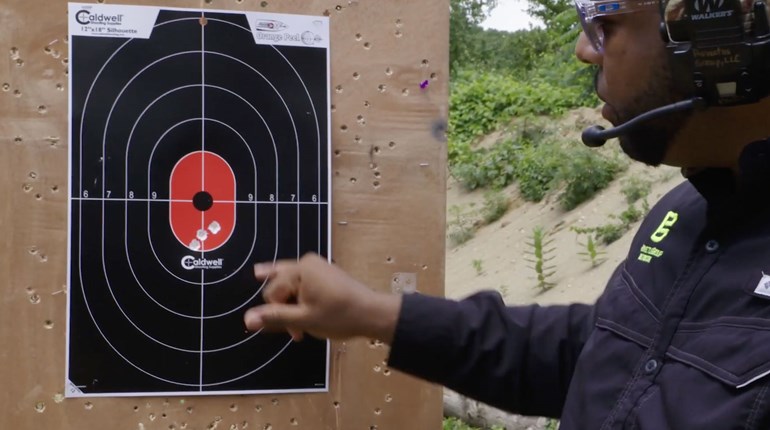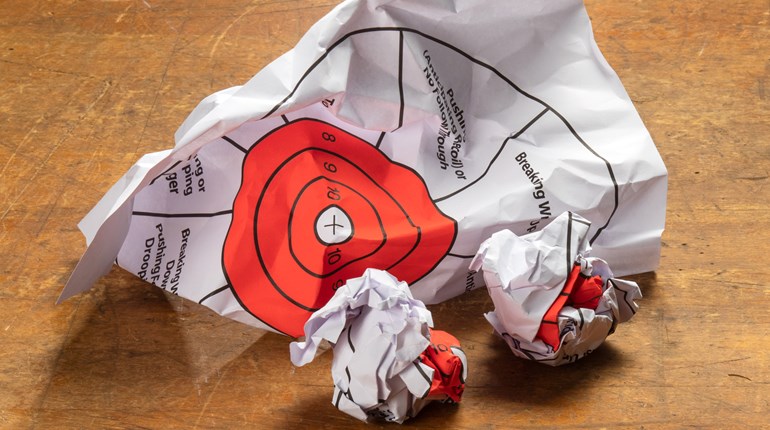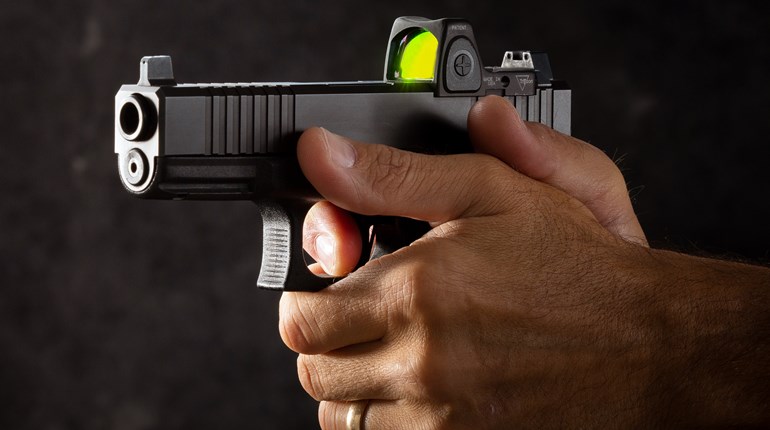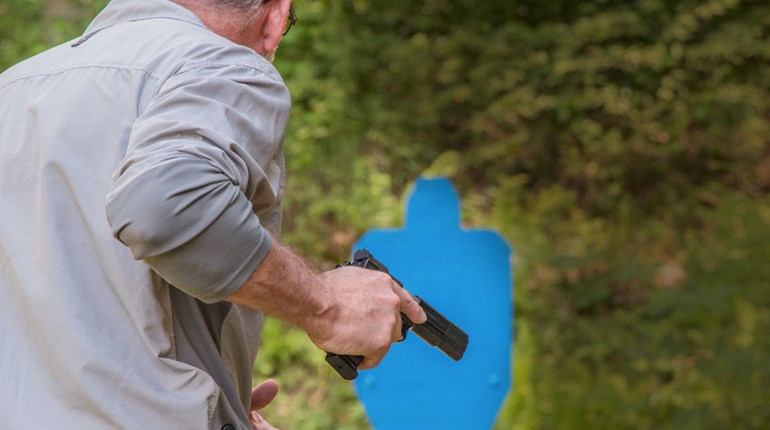
Who wrote it? Where did it come from? How old is it? Does it apply to the firearm I am using? Does it apply to the firearms I shoot? Does it even apply to me?
I teach a lot of classes, as I explained in my previous article (“Trigger Jerk is a Myth,” December 2021). I record and coach between five and eight videos every day I’m on the range. Also, I’ve been teaching video-diagnostic classes for 10 years now, and here is what I see: As I wrote in the aforementioned article, what I realized was a big part of the trigger-jerk myth is the pie-chart target we’ve all seen either in person or online. Putting it simply, the pie chart is unequivocally junk science.
What I mean by that is the pie chart doesn’t really give you any good information. As you go around each “slice” of the pie chart, what you’re going to realize is its premise is paper-thin. I’m going to ask you a couple questions about each of those slices. What I’ve learned is no one has good or even “just OK” answers. In all my time doing video diagnostics, no one has ever given me a good answer to anything on the pie chart. The exception is the standard reply of “trigger jerk,” which I showed to be—or at least got you thinking about it being—a myth in last month’s article.
However, the trigger-jerk myth was a slice from the pie chart. My questions about the pie chart are: What is its origin? How old is it? Is it for double-stack, modern guns? If the pie chart isn’t for double-stack guns and shooting with one or both hands, then it’s worthless to those who carry or train with such firearms. More about that later.
Let’s start at the 12-o’clock position and go around the pie chart, in turn examining each slice of the pie and its purported diagnostic result.
Wrists Breaking Up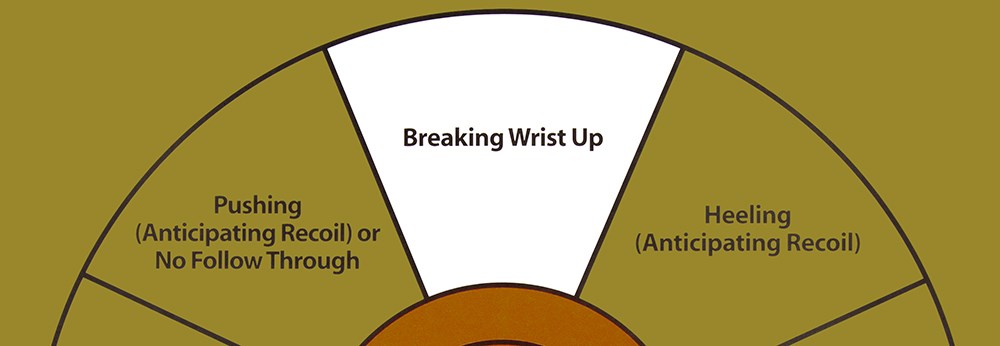
If you were watching video in slow motion of a handgun being discharged, this is what would happen before the pistol goes off. Wrists would break, canting the gun upward. The muzzle of the gun would be up in the air before the gun fires. The gun would discharge only after the front is pointed up. That’s what it would look like on video. Has anyone ever seen that? Take a minute and think about it. I’ll tell you I’ve never seen that on a video or in real life.
Heeling and Anticipating Recoil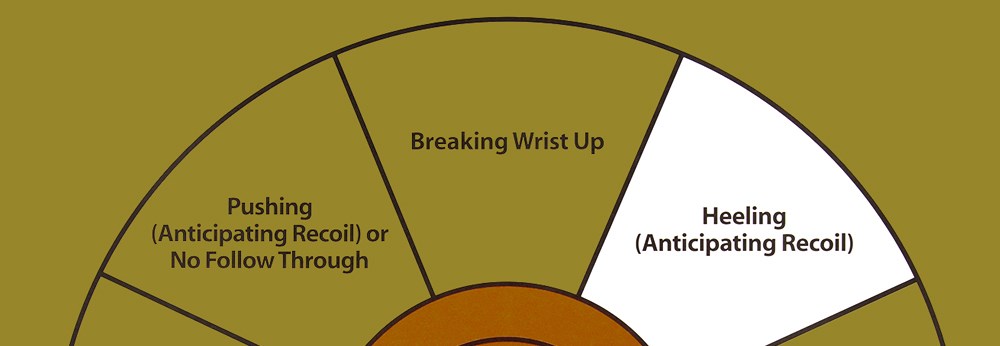
What does “Heeling” mean and how does it get the bullet to go high and right every time? Some of the answers I’ve heard over the years: Pushing the heels of the hand into your gun, causing the muzzle of the gun to go up and right. I have also heard that placing your weight on the heels of your feet will also cause the muzzle to go high and right. Why such explanations? Because no one knows what “heeling” actually means. In all the videos I’ve taken, I’ve never seen it occur with either the hands or the feet, nor has it ever been a problem. If it were, folks would’ve figured out a corrective measure by now. This slice also says you are “anticipating recoil.” Therefore, if you anticipate the shot, the bullet will go up, yet from what I’ve seen and what most people are taught, anticipating recoil will cause the bullet to go down. It can’t be both.
Too Much Trigger Finger, Thumbing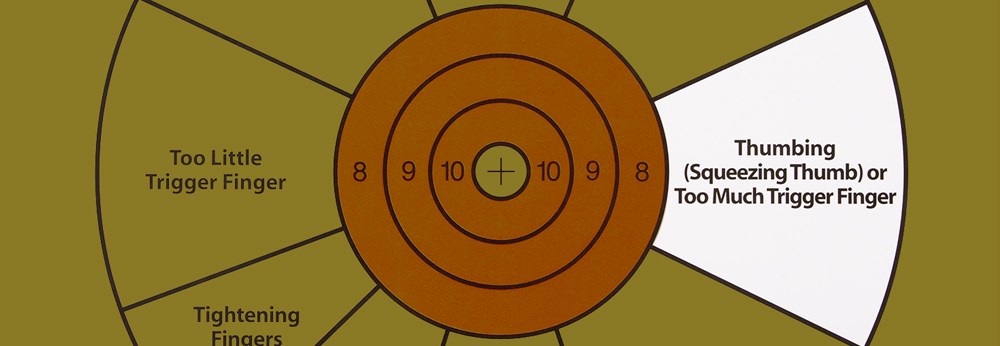
As I explained in the prior article, “Too much trigger finger” is as erroneous a concept as “Too little trigger finger.” It has to do with hand and gun size. Again, finger placement on the trigger does not affect where the bullets impact. You can place as much pressure as you want to the trigger. “Thumbing” is only a temporary fix. If, as a right-handed shooter, you shoot to the left of center mass, driving both of your thumbs to the right into the frame and slide will get you back into the middle of target. That much is true. But the fix won’t last. Why not? Well, for most of us, “Gun hot. Gun burn thumb. Brain pull thumb away.” Now, you’re back to shooting to the left. However, thumbing doesn’t start at the 3-o’clock position on the chart; it starts at 9 o’clock, outside of the chart. So, thumbing isn’t in the right space to actually help you. And it’s only a temporary fix until the gun is hot.
Tightening Fingers or Tightening Grip While Pulling the Trigger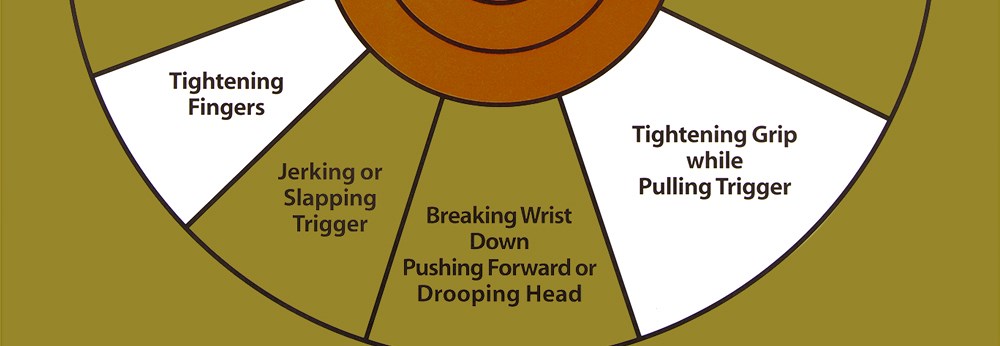
I’ll talk about these two slices of pie together, since they are, frankly, just about the dumbest things I’ve ever heard. If you watch a pro shooter, let me ask you one question: Does he or she have a loose grip or a tight grip? A pro shooter has a good grip on a gun, yes? Good grip equates to how they control it so well. But, what the pie chart says is you are gripping too tight (or tightening a loose grip). You are never going to control the gun well if you hold it loosely, so why were you doing that in the first place? I would also say that this applies to the “60/40” notion. The problem is, what does 60-percent grip or 40-percent grip mean? Here’s the way your brain sees it: 60- or 40-percent grip is not gripping the gun hard, ergo you will never grip the gun hard. The brain will rationalize that you actually never have
to grip the gun hard, since whatever you do the 60 and the 40 will always add up to 100 percent. This is a bigger detriment to your ability to shoot accurately than anything else you might have learned.
As for tightening the fingers, how did you even get the gun out of the holster? You have to have a pretty good grip to defeat a lock or friction retention on a holster. I can’t believe these two things ever made it onto the pie chart and no one called them into question. What you should do is apply “200 percent grip”—always (that’s 100 percent with each hand). It’s a gun; the better you can grip it, the better you’re going to shoot it.
Breaking Wrists Down, Pushing Head Forward or Drooping Head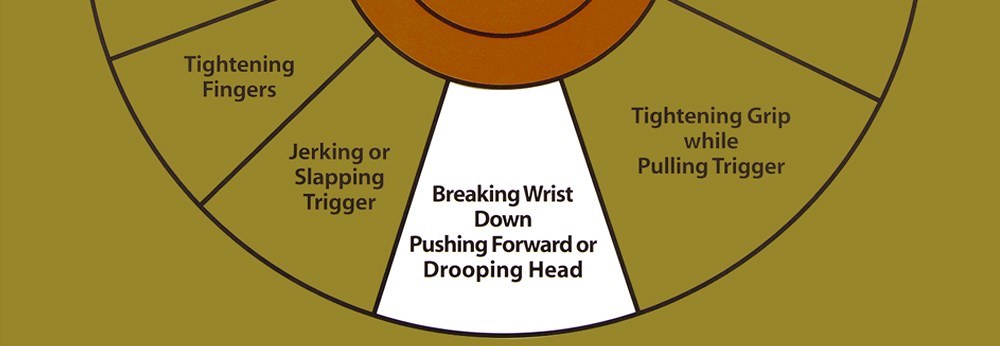
The 6-o’clock position of the pie chart accuses the shooter of “Breaking wrists down,” “Pushing head forward” or “Drooping head.” Sure, this could be happening. But the bottom of the 6-o’clock segment of the circle attests to alleged “Anticipation.” So, all this is just fluff for saying anticipation which, according to the pie chart, makes bullets go everywhere, here included. In this slice, it is correct, since anticipation will likely make you miss low. But why not just say that?
I just went around every slice of the pie chart and asked myself a couple of simple questions. As soon as you question these “pointers” for more detail, the chart’s logic breaks down and you realize there’s no real information here.
Slapping or Jerking Trigger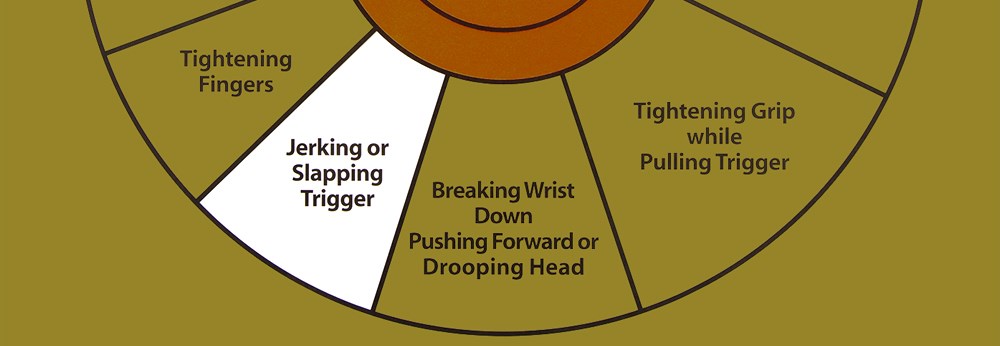
This takes us to the infamous trigger jerk or slapping the trigger slice of the pie. For the full story, read my previous article, but I’ll tell you, jerk that trigger every time and jerk it as hard as possible. Here’s why: It’s an on-and-off switch, a linear device and either you’re on it or you’re not. The only reason you even heard of trigger jerk is because its origin resides on the pie chart. If it wasn’t for the pie chart, there would be no such thing as trigger jerk. This is why it’s the pie chart is junk science. You think you see trigger jerk on the target, but what if the pie chart is wrong? That would mean trigger jerk is a myth. I’ll get into the origin of the pie chart in a little bit.
Too Little Trigger Finger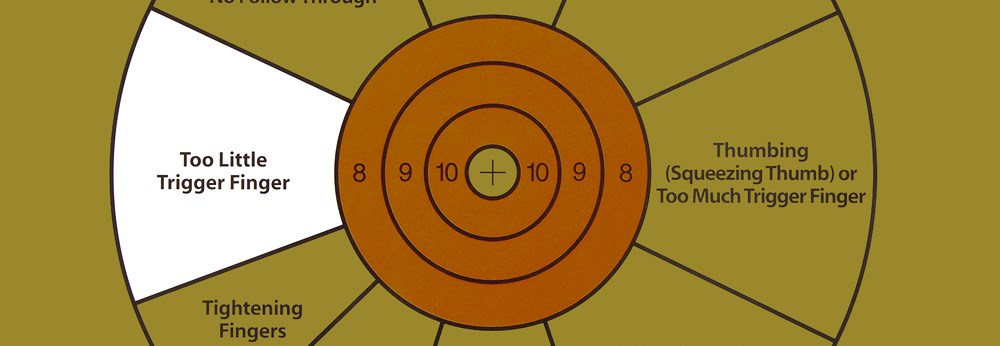
Again, refer back to the “Trigger Jerk is a Myth” article. “Too little trigger finger” has to do more with the size of the gun and the size of your hand. Also, many modern triggers have a safety mechanism in the center of the trigger itself. To even pull the trigger, your finger has to reach the center of the trigger or farther. Besides, it doesn’t matter what you do to the trigger, because finger placement on the trigger of a properly held handgun does not affect where the bullets go.
Pushing, Anticipating Recoil and No Follow Through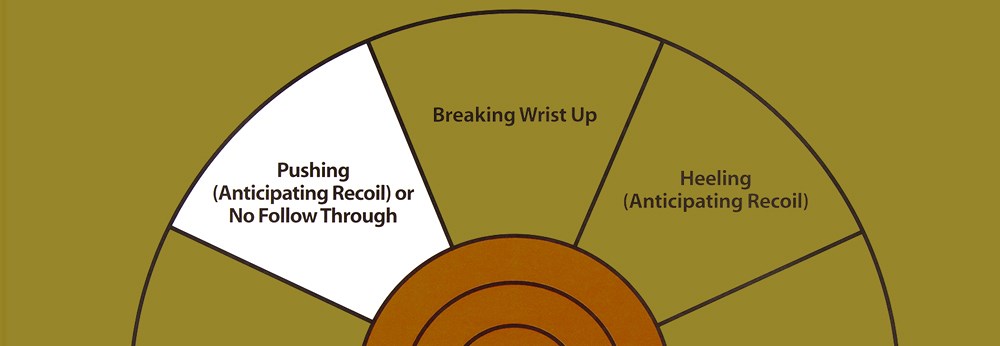
What does “Pushing” mean and how does it get the bullet to go high and left? Take a minute and think about it. I’m going to tell you right now, if you push anything—your hands, your body, anything—toward the target, bullet impact generally goes down. When you shoot a full-automatic gun, it wants to naturally go up. When you realize it’s going up, what do you do? You push forward into the gun and it goes down. Pushing anything toward the target is
going to have a downward effect on your point-of-impact. And again, no one seems to know exactly what “pushing” means beyond that, which makes it unlikely to result in bullets landing in this slice of the pie chart. Next in this slice is “Anticipating Recoil.” As mentioned above, anticipation causes the bullet to impact low, not high and to the left. Anticipation is always low, and we’ve all seen that result. Which leads me to “No Follow Through.” Think about this as follow through: I shoot, then I take the slack out of the trigger. I level the gun and center the sights and I’m ready to shoot again. I take the gun to the very edge of being ready to shoot again. If I don’t do this, all my bullets will go high and to left? That’s just not going to happen.
Pie Chart Use
Years before the internet, I found a pie chart for lefties in some shooting book. For years, I carried it, comparing it to my groups on the target. I used the left-handed pie chart thinking that between righties’ occasionally dubious advice and my special chart, I’d be kept straight.
As it turned out, the pie chart never helped me once—not one time in all the years I carried it.
Pie Chart Origin
In searching for the origin, I had some internet deep-diver guys look into it for me. They could not find the origin of the pie chart. So, how do I know what it’s for? Is it for slingshots, for bows and arrows, for muzzleloaders? Also, it seems that this has been around a long, long time and, if so, is it even useful for modern guns? If there’s no origin, tell me how it applies to anyone? More importantly, why should I believe it without question? That’s what has led me to believe the pie chart is nothing but junk science.
We have two options from this point: We can just keep believing in the pie chart and keep repeating its dogma, or we can apply our intellect and keep digging. Continuing to do the same thing over and over and expecting different results is the definition of insanity, so we shouldn’t do that.
What the Pie Chart Is
I would like to formally state my opinion that the pie chart is unalloyed crap. What you should really be asking yourself is not if trigger jerk is real, but what—if anything—is the legitimacy of the pie chart? This seems like a “What came first, the chicken or the egg?” question. Did trigger jerk come first and someone put it on the pie chart? Or did the pie chart come first and everyone started calling it trigger jerk? Either way, we don’t know where either fairly useless thing comes from.
Trigger jerk is a myth, and the pie chart is the scroll the myth is written on—nothing more. Grip tight, aim right (that is to say, correctly) and you’ll hit center.












